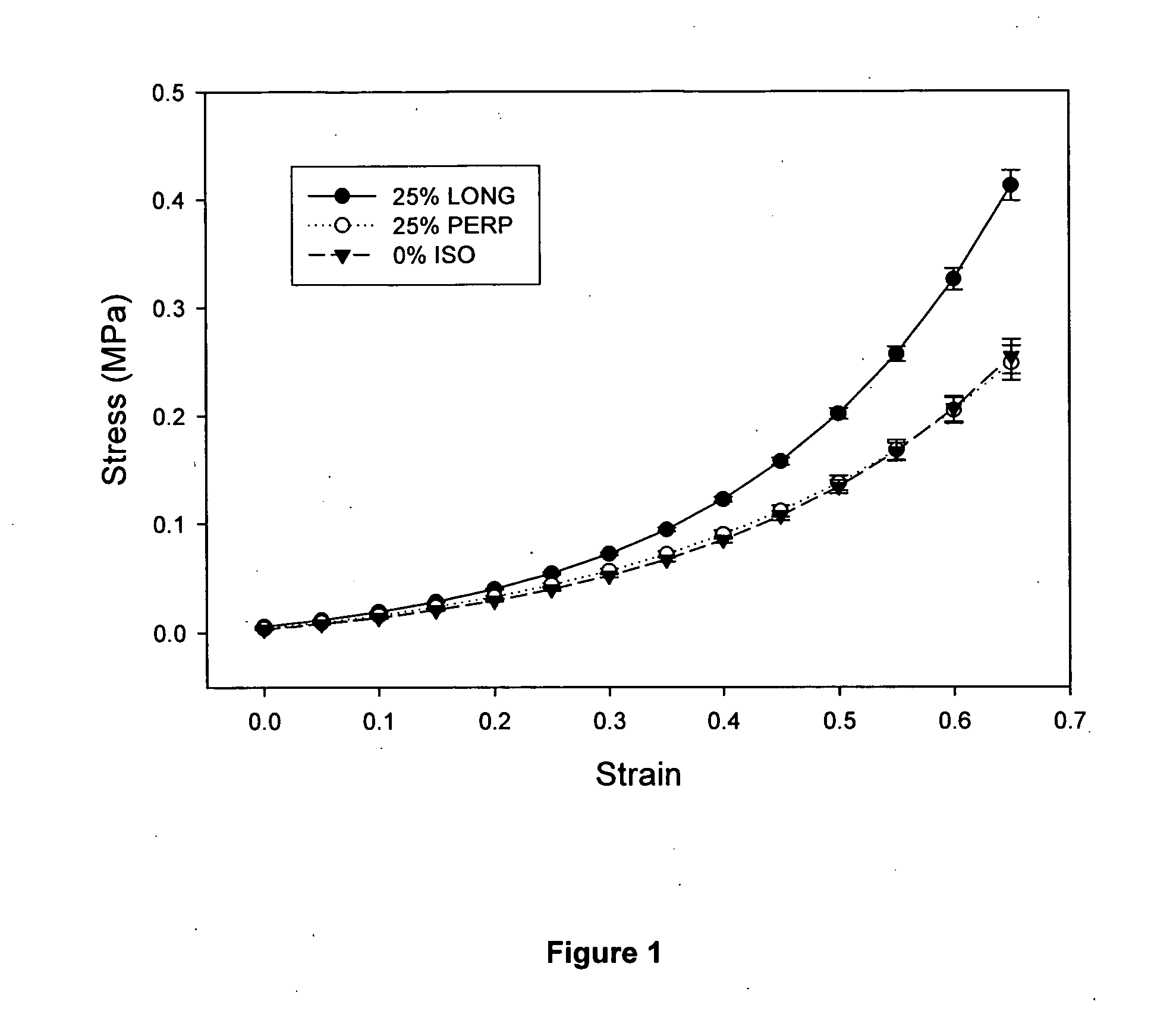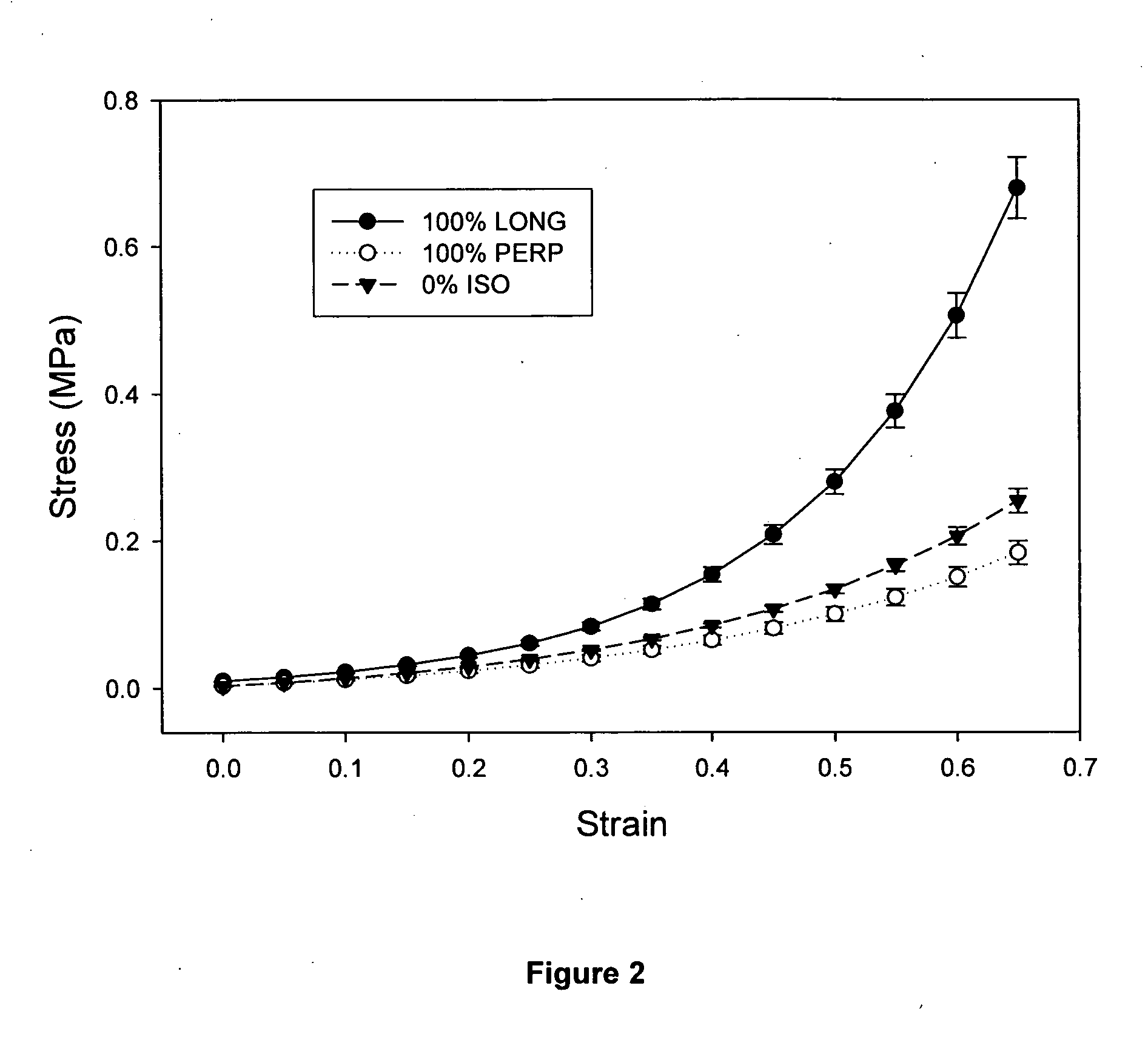Anisotropic nanocomposite hydrogel
a nano-composite, anisotropic technology, applied in the direction of powder delivery, on/in organic carrier, medical preparations, etc., can solve the problems of morbidity for patients with renal failure, haemodynamic changes, tissue graft deterioration, etc., to achieve high anisotropy, increase stiffness, and high strain
- Summary
- Abstract
- Description
- Claims
- Application Information
AI Technical Summary
Benefits of technology
Problems solved by technology
Method used
Image
Examples
example 1
[0079]PVA (Sigma-Aldrich Canada) with a molecular weight (Mw) of 146,000-186,000, 99+% hydrolyzed, was used in all solution preparations. A suspension of 0.625 wt % bacterial cellulose in distilled water was produced in shake flasks by fermentation using the bacteria Acetobacter xylinum, as described by Guhados et al.[42]. PVA was added to the bacterial cellulose suspension with additional distilled water to obtain a mixture of 10 wt % PVA with 0.3 wt % bacterial cellulose.
[0080]The PVA-bacterial cellulose solution was transferred into seven aluminum molds and placed in the heated / refrigerated circulator, where they were cycled once between 20° C. and −20° C. to give cycle 1 samples. For a study of the effect of initial strain, one of the samples was used as control while the four other samples were transferred into the four custom design molds where they were initially strained by 25, 50, 75, or 100% of the original length. The four stretched samples and the contr...
example 2
Tensile Testing and Analysis
[0083]Testing equipment used in the studies consisted of a servo-hydraulic material testing system (INSTRON 8872) equipped with a 1 Kg load cell. Sample thickness was measured using a Mitutoyo thickness tester, and testing was carried out inside a Plexiglas tank filled with distilled water (at 37° C.). All the specimens were secured onto custom designed tissue grips (10 mm grip-to-grip distance), and tensile tests were performed at a crosshead speed of 40 mm / s to a maximum of 65% strain. Prior to the tensile tests, all specimens were preconditioned with 10 loading and unloading cycles. All data obtained was in the form of load-extension, which was then converted into engineering stress-engineering strain, using the sample thickness and the initial gauge length after preconditioning, as reported previously.
[0084]The stress-strain data for PVA-bacterial cellulose nanocomposites is nonlinear and takes on the general shape of curving up towards the stress axi...
example 3
Effect of Initial Strain
[0087]FIGS. 1 and 2 show the effect of 25 and 100% initial strains, respectively, on anisotropy relative to the isotropic control. Samples in the longitudinal direction showed higher stiffness than in the perpendicular direction, with the results for isotropic control falling in between or close to the perpendicular direction. Comparing FIGS. 1 and 2, the longitudinal direction displays higher stiffness at the 100% initial strain compared to 25%, as well as a larger difference between the longitudinal and the perpendicular directions. The data in FIG. 1 does not show a statistically significant difference at 65% strain between the perpendicular and isotropic control (p>0.05), but both of them were statistically different from the longitudinal samples (p<0.05). In FIG. 2, a statistically significant difference in stress at 65% strain (p<0.05) among all three samples was observed. Samples using initial strains of 50, 75% were also prepared and tested, with resu...
PUM
| Property | Measurement | Unit |
|---|---|---|
| temperature | aaaaa | aaaaa |
| temperature | aaaaa | aaaaa |
| temperature | aaaaa | aaaaa |
Abstract
Description
Claims
Application Information
 Login to View More
Login to View More - R&D
- Intellectual Property
- Life Sciences
- Materials
- Tech Scout
- Unparalleled Data Quality
- Higher Quality Content
- 60% Fewer Hallucinations
Browse by: Latest US Patents, China's latest patents, Technical Efficacy Thesaurus, Application Domain, Technology Topic, Popular Technical Reports.
© 2025 PatSnap. All rights reserved.Legal|Privacy policy|Modern Slavery Act Transparency Statement|Sitemap|About US| Contact US: help@patsnap.com



